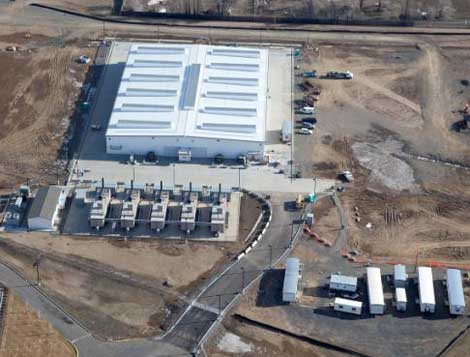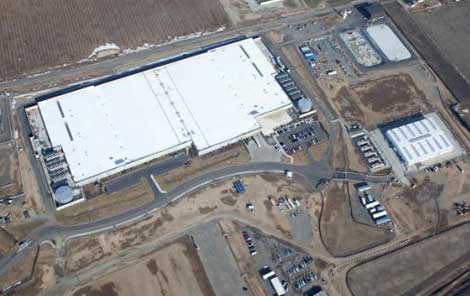
An aerial view of the new Microsoft data center in Quincy, Washington, which uses a lightweight structure and modular data centers. (Photo: Microsoft Corp.)
When it comes to data center design, Christian Belady isn’t afraid to shake things up. Back in 2008, Belady and his Microsoft colleague Sean James put a rack of servers in a pup tent for eight months, with 100 percent uptime.
That experiment helped the data center industry rethink assumptions about the impact of temperature and humidity on server health – which in turn convinced many data center operators to turn down the air conditioning and use more fresh air in cooling systems.
The pup tent casts a long shadow when Belady talks about coming changes in data center design. As the director of Datacenter Research at Microsoft, Belady is pondering the next phase of change in data center design.
“Cloud computing is the utility of the future,” says Belady. “I look at it as a way to distribute energy. At the end of the day, data is energy.”
Data and Power Closely Linked
So what will the cloud computing “grid” of the future look like? At a time when Internet infrastructure closely tracks the availability of cheap electricity, Belady says the key questions will involve the relationship between data and power.
"Data is really a processed form of electricity,” Belady says. “We're part of this ecosystem: an energy pipeline. If you started from scratch, what with that whole pipeline look like? How does that change infrastructure? How can we deploy the cloud?”
These are not academic questions. Belady is the guy at Microsoft tasked with translating these big-picture concepts into data center designs that can support tens of millions of users. He says Microsoft is already developing new facilities optimized for this vision of cloud data centers as “data utilities.”
“We've only started to scratch the surface of what that really means,” he said. “There's this extreme drive to lower the cost of the cloud. There has to be a financial benefit.”
Areas for Future Innovation
Where will these savings come from? And how will they change how Microsoft builds and deploys its data centers? Belady isn’t ready to say just yet. But in a recent conversation with Data Center Knowledge, Belady discussed several broad themes that are in the mix as he ponders the road ahead for Microsoft's data centers.
Temperature and Humidity Ranges: Belady has been a strong advocate of wider temperature ranges for data centers, arguing that servers are far heartier than once imagined. Microsoft is regularly operating at or above 80 degrees F in its data centers, and has said it can run as high as 95 degrees F if needed. "I honestly believe we should be pushing further," Belady said.
Failing in Place: The notion of an unmanned "lights out" data centers has been widely discussed but lightly implemented. With its move to a factory-built modular IT-PAC (short for "pre-assembled component), Microsoft has taken a big step toward data center capacity that can be lightly maintained. "When a server fails, why does it need to be replaced?" Belady asks."Why can't the servers just fade away? What you don't have to maintain servers, it creates opportunities."
On-Site Power: Given Microsoft's interest in renewable energy, Belady's discussion of a utility model for cloud computing raises obvious questions about on-site generation for future data centers. "Clearly, our expertise is not in energy generation," said Belady. "The objective isn't to replace that (electric utility) infrastructure. It’s going to be a partnership between people with the right competencies."
Geography and Site Location: When Microsoft first developed the IT-PAC modular deployment model, it considered building data centers with no roofs, but ultimately opted for a lightweight building. Belady remains intrigued by the roof-less data center, an approach that would influence its site location decisions. But the servers won't be housed in tents.
"When we did the 'tent city,' we weren't saying that's what a data center should look like,"said Belady. "It's saying 'here's an example of what's possible' and showed that things would be okay. We need to convince the industry that there is opportunity there."
Belady says the industry has responded, noting the growing adoption of free cooling and slightly higher temperatures in the data center.
"I think the industry has moved quite a lot in the last three or four years. The fact that the industry started sharing woke people up that there's different ways to do things. We can't build data centers the way we used to."
Belady says Microsoft will continue implementing new ways to build data centers for a changing industry. "We're taking big steps, and we'll learn along the way," he said. "That's why I get excited."

An aerial view of the two Microsoft data centers in Quincy, Washington illustrates the evolution of ts design. The new modular data center at right deploys capacity in a more compact footprint that the previous 470,000 square foot facility. (Photo: Microsoft Corp.)




